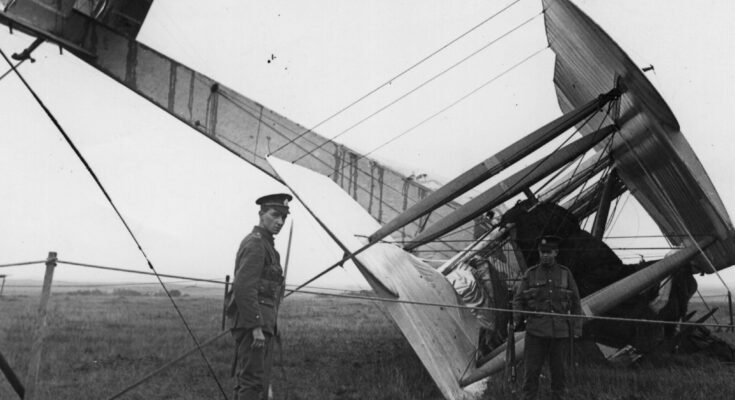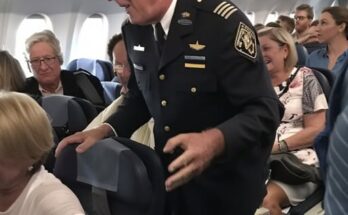A sextant, alcohol, and coffee helped John Alcock and Arthur Whitten Brown cross the Atlantic in 1919, eight years before Charles Lindbergh’s trip.
English pilot Captain John Alcock telegraphed his account to newspaper reporters worldwide when it was all done. He and his flying companion, Arthur Whitten Brown, had just experienced a perilous plane crash in Ireland, and he was worn out from the adventure. Alcock wrote, “We have had a terrible journey.” The fact that we are here at all is remarkable. We hardly ever saw the stars, moon, or sun. We hadn’t seen any of them for hours.
Had you stopped reading there, you could have concluded that Alcock and Brown’s expedition had been unsuccessful. They had been stuck in a primitive aircraft in terrible weather for sixteen tense hours. Their only navigational tool was a sextant, which measured celestial objects in reference to the horizon. Brown had almost never been able to locate them because of the numerous mistakes they had made on their trek and the fact that fog and clouds had obscured the stars most of the time.

However, their voyage was a success. The first individuals to fly continuously across the Atlantic Ocean were Alcock and Brown, notwithstanding their ungainly landing in a swamp on June 15, 1919. The two pilots created history almost ten years before Charles Lindbergh captured the public’s imagination with his own transatlantic journey. Their risk paid off, as the two not only became trailblazing aviators but also defeated a group of rivals striving in a fierce competition for a hefty monetary reward to become the first transatlantic aviators.
Alfred Harmsworth, 1st Viscount Northcliffe, a British newspaper magnate and owner of The Daily Mail, one of the most significant newspapers in England, was the driving force behind the reward. Lord Northcliffe was attracted by new forms of transportation, just like many other magnates of the day. When air travel was still a novelty, a handful of avant-garde aviators sought to push the boundaries of technology with the help of wealthy backers like Northcliffe.
Northcliffe was one of the first members of the Aero Club in England, a club of aviation enthusiasts dedicated to promoting and growing air travel. He promised the first balloonist to fly from London to Manchester a reward of ten thousand pounds in 1906. At the time, ten thousand pounds was a substantial sum of money, equivalent to approximately 600,000 dollars now.
Northcliffe persisted in awarding rewards for achievements in aviation, which increased awareness of his publication and sparked rivalry among pilots. The prize money was also a part of a wider pattern of highly publicized technology contests that honored early adopters of new innovations, such as aviation.
The public watched as daring drivers, cyclists, and pilots achieved industry firsts and gradually pushed the boundaries of modern technology. Pilots who set records in distance and speed were awarded air prizes, and those who placed first or second went on to become well-known figures.
The most audacious prize that Northcliffe offered was for a transatlantic journey. The reward offered 10,000 pounds to a pilot who managed to cross the Atlantic in less than 72 hours, not just from a location in North America to Great Britain or Ireland, a feat that had not yet been completed.
Because the aircraft of the 1910s were so antiquated, winning the prize appeared improbable.That was altered by World War I. Although the Great War temporarily ended the rivalry, it also advanced plane technology by turning flying into a weapon of mass destruction. As a result, the aviation sector expanded and flight technology advanced significantly. A cadre of combat-tested pilots and aircraft that had served as weapons of war were prepared to compete for the prize by the end of the conflict.
Alcock and Brown, two military pilots who were taken prisoner during World War I, were among them. Alcock had a dream of flying across the Atlantic while he was imprisoned. He started working toward realizing his dream after the war.

There were other pilots who had the same goal as him. Teams of pilots and manufacturers of aircraft competed for the reward, but they kept failing. A group of Coast Guard and Navy airmen crossed the Atlantic in May 1919 in the NC-4, an aircraft that required three weeks and numerous pauses to complete. However, the NC-4 created history but was not awarded the prize since Northcliffe’s contest was restricted to non-military fliers and required the trip to be finished in 72 hours without pauses.
In an attempt to defeat Alcock and Brown, a different team, supported by the British aviation manufacturer Handley Page, dispatched a plane to Newfoundland in advance of the race. Together with a Vickers Vimy bomber that had been altered for transatlantic travel, Alcock and Brown were also there. Alcock and Brown began their flight attempt on June 14, 1919, while the Handley Page crew was left inactive while its commanders carried out flight testing.
It was a catastrophe. It was a rocky and dangerous takeoff. Subsequently, the radio stopped working. The pilots were overtaken by fog, which made sextant navigation nearly difficult. The plane quickly developed an ice coat. The men froze, sitting in an open cockpit. Alcock occasionally lost all control of the aircraft and crashed into the water. Their engine clogged on ice at another and stopped operating.
“We completed the circle,” Alcock remembered. “We pulled off some very funny antics because I couldn’t see the horizon.”
The men flew and flew, blinded by the rain and unsure of where they were exactly.They sang and worried about whether the harsh weather would harm their fuel tanks while they passed the time, fueled by sandwiches, coffee, and alcohol.

They suddenly realized, almost unbelievably, that they were above land. It wasn’t a smooth landing, though. Instead, they plunged the aircraft nose-first into an Irish bog. The men were thrilled but confused. They had just created history, even though they had crashed.
They had hoped that the press would be notified by wireless radio of their landing, but the radio had gone out so early in the trip that they were unable to notify them of their success. They telegraphed the Aero Club instead. Alcock later wrote about the trip in a cable to the Daily Mail. He wrote, “The flight has demonstrated that the Atlantic flight is feasible.”
It was a huge accomplishment. Alcock and Brown’s achievement made headlines and hinted at a time when traveling across oceans would be routine. George V knighted the pair after they received the prize money, which was given to them by British aviation secretary Winston Churchill.
Alcock did not live to experience knighthood; he passed away in 1919 following the crash of another Vickers aircraft he was piloting in France. Brown, nonetheless, persisted in flying despite the difficult circumstances. He served in the Royal Air Force and British Home Guard during World War II. He passed just a few years following the plane crash death of his son, Arthur Brown.
What, then, was the navigator’s assessment of the historic trip that had presented such a difficulty? The flight had been a triumph of man and machine, in spite of the dread, the cold, and the absence of stars for navigation. Alcock and Brown were rescued from their crash landing by wireless radio operators, who also provided them with breakfast and assisted them in telegraphing their victory. Brown uttered, “This is the best way to cross the Atlantic,” following his meal.



